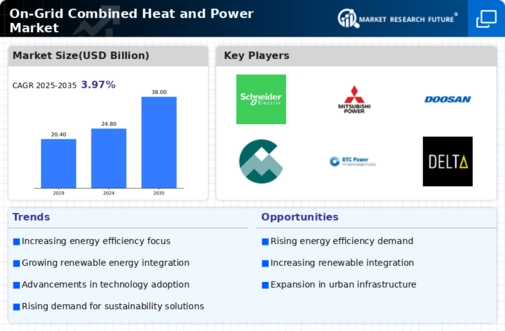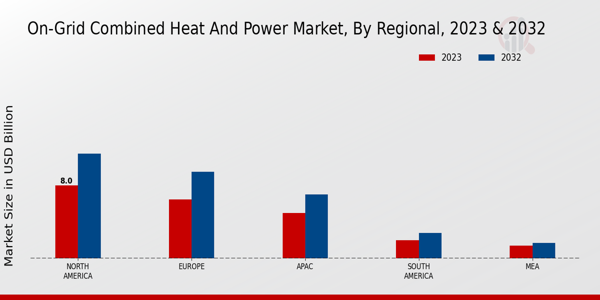Technological Advancements
Technological advancements are a key driver in the Global On-Grid Combined Heat and Power Market Industry. Innovations in system design, efficiency improvements, and the integration of smart technologies are enhancing the performance and reliability of combined heat and power systems. For example, advancements in microgrid technology allow for better management of energy resources, optimizing the use of generated heat and power. These developments not only improve operational efficiency but also reduce maintenance costs, making these systems more attractive to potential users. As technology continues to evolve, the market is expected to see increased adoption across various sectors.
Increasing Energy Efficiency
The Global On-Grid Combined Heat and Power Market Industry is driven by the growing emphasis on energy efficiency. As industries and municipalities seek to reduce energy consumption and operational costs, combined heat and power systems present an attractive solution. These systems can achieve efficiencies of up to 80 percent, significantly higher than traditional energy generation methods. This trend is particularly evident in Europe and North America, where regulatory frameworks encourage the adoption of such technologies. The market is projected to reach 24.8 USD Billion in 2024, reflecting the increasing investment in energy-efficient solutions.
Market Trends and Projections
The Global On-Grid Combined Heat and Power Market Industry is characterized by several trends that indicate its future trajectory. The market is projected to reach 24.8 USD Billion in 2024 and is expected to grow to 38.0 USD Billion by 2035. This growth reflects a compound annual growth rate of 3.97% from 2025 to 2035. Factors such as increasing energy efficiency, government incentives, and technological advancements are contributing to this upward trend. The market's expansion is likely to be influenced by the rising demand for renewable energy and the growing industrial applications of combined heat and power systems.
Growing Industrial Applications
The Global On-Grid Combined Heat and Power Market Industry is experiencing growth due to the expanding industrial applications of combined heat and power systems. Industries such as manufacturing, food processing, and pharmaceuticals are increasingly adopting these systems to meet their energy needs while minimizing costs. The ability to generate both electricity and useful heat from a single fuel source allows these industries to enhance their operational efficiency. As more sectors recognize the benefits of combined heat and power, the market is poised for growth, with projections indicating a robust expansion in the coming years.
Government Incentives and Policies
Government incentives and supportive policies play a crucial role in the Global On-Grid Combined Heat and Power Market Industry. Many countries are implementing regulations that promote the use of combined heat and power systems as part of their commitment to reducing greenhouse gas emissions. For instance, tax credits, grants, and subsidies are often provided to encourage the installation of these systems. This regulatory support is expected to drive market growth, with projections indicating a market size of 38.0 USD Billion by 2035. Such initiatives not only enhance energy security but also stimulate economic growth through job creation in the energy sector.
Rising Demand for Renewable Energy
The increasing demand for renewable energy sources significantly influences the Global On-Grid Combined Heat and Power Market Industry. As nations strive to transition to cleaner energy systems, combined heat and power technologies are being integrated with renewable sources such as biomass and solar energy. This integration allows for a more sustainable energy mix, reducing reliance on fossil fuels. The market is anticipated to grow at a CAGR of 3.97% from 2025 to 2035, reflecting the shift towards renewable energy solutions. This trend is particularly pronounced in regions with abundant renewable resources, where combined heat and power systems can enhance energy resilience.






















Leave a Comment